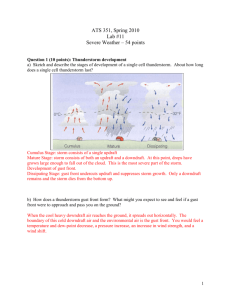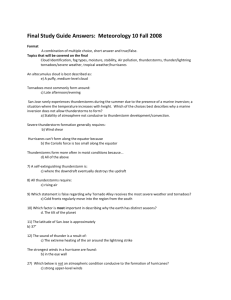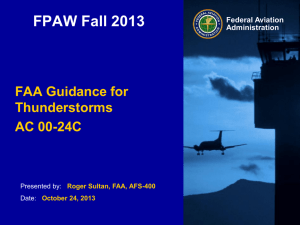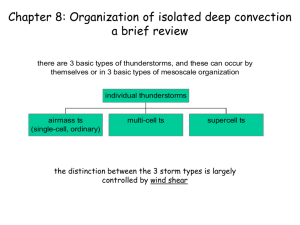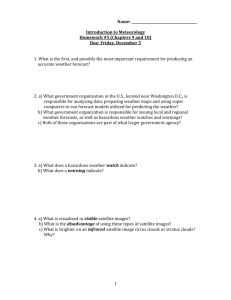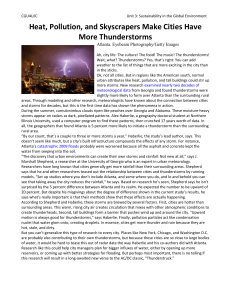Thunderstorms - College of DuPage
advertisement
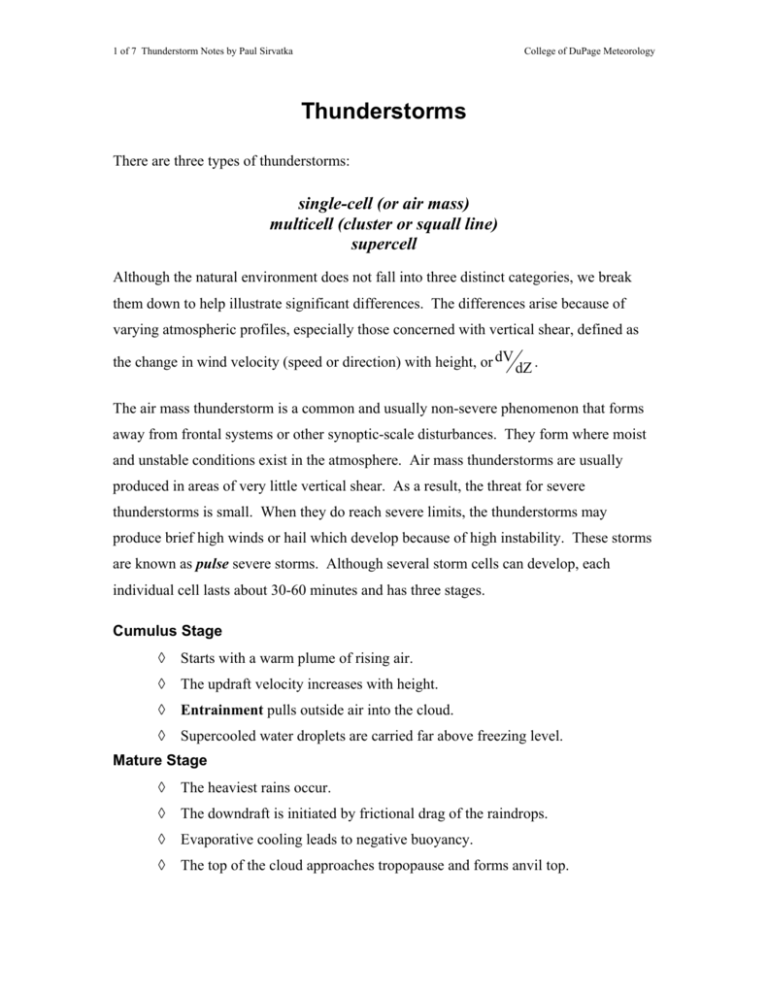
1 of 7 Thunderstorm Notes by Paul Sirvatka College of DuPage Meteorology Thunderstorms There are three types of thunderstorms: single-cell (or air mass) multicell (cluster or squall line) supercell Although the natural environment does not fall into three distinct categories, we break them down to help illustrate significant differences. The differences arise because of varying atmospheric profiles, especially those concerned with vertical shear, defined as the change in wind velocity (speed or direction) with height, or dV dZ . The air mass thunderstorm is a common and usually non-severe phenomenon that forms away from frontal systems or other synoptic-scale disturbances. They form where moist and unstable conditions exist in the atmosphere. Air mass thunderstorms are usually produced in areas of very little vertical shear. As a result, the threat for severe thunderstorms is small. When they do reach severe limits, the thunderstorms may produce brief high winds or hail which develop because of high instability. These storms are known as pulse severe storms. Although several storm cells can develop, each individual cell lasts about 30-60 minutes and has three stages. Cumulus Stage ◊ Starts with a warm plume of rising air. ◊ The updraft velocity increases with height. ◊ Entrainment pulls outside air into the cloud. ◊ Supercooled water droplets are carried far above freezing level. Mature Stage ◊ The heaviest rains occur. ◊ The downdraft is initiated by frictional drag of the raindrops. ◊ Evaporative cooling leads to negative buoyancy. ◊ The top of the cloud approaches tropopause and forms anvil top. 2 of 7 Thunderstorm Notes by Paul Sirvatka College of DuPage Meteorology Dissipating Stage ◊ The downdraft takes over entire cloud. ◊ The storm deprives itself of supersaturated updraft air. ◊ Precipitation decreases. ◊ The cloud evaporates. As wind shear organizes the convection, new thunderstorms form as a result of parent thunderstorm outflows converging with warm, moist inflow creating new updrafts. Multicell storms can form in a line known as a squall line, where continuous updrafts form along the leading edge of the outflow, or gust front. Multicell clusters indicate new updrafts are forming where the low-level convergence is strongest, usually at the right, or right-rear flank of existing cells. Thunderstorms that organize in response to synoptic scale forcing usually need: - warm, moist air at low levels - cool, dry air at upper levels - upper-level divergence (above 500mb) - a synoptic scale disturbance In these conditions, thunderstorm formation is probable. Synoptic scale vertical motions tend to create favorable conditions for thunderstorms, but thunderstorm initiation is usually a result of mesoscale forcing. Increasingly favorable vertical wind profiles may lead to a greater possibility of supercell development rather than multicell storms. The development of squall lines, or more commonly storm clusters, when thunderstorms do develop is virtually guaranteed in association with strong linear synoptic scale forcing. Multicellular storms consist of a series of evolving cells. At low levels, cooler air diverging from the downdraft intersects the inflowing air along a gust front, creating a region of strong low-level convergence favorable for new updrafts. It is the presence of vertical wind shear that results in the "tilting" of the updraft and downdraft. Because of the tilting, the less buoyant downdraft air will not destroy the updraft and hence deprive itself up supersaturated updraft air. In any case, the movement of multicell storms systems is determined by combining the new cell development with the mean winds. Each individual cell typically moves with the mean winds of the cloud-baring layer, 3 of 7 Thunderstorm Notes by Paul Sirvatka College of DuPage Meteorology while new cells develop where the inflow meets the outflow, hence, in the region of strongest surface, or low-level, convergence. Supercells are the most powerful thunderstorms. Almost by definition, supercells are severe. Supercells are responsible for a disproportionate amount of damage and casualties. The most significant difference arises from the presence of a rotating updraft, or mesocyclone. These features M icrobursts Pulse Storm s Flash Floods insure the longevity Supercells of a thunderstorm by allowing the Draft Strength (Increasing Event Intensity) flanking line to Squall Lines M ulticell Com plexes enhance the inflow into one main O rdinary T hunderstorm s (Single and M ultiple Cells) updraft, rather than helping create new updraft centers. Shear (Increasing Lifetim e) The combination of rotation and longevity increase the chances for the development of strong or violent tornadoes when other conditions are present, such as low LCL’s and abundant storm relative shear in the sub-cloud layer. Mesocyclone – A region of strong and persistent rotation that is well-correlated with the updraft of a thunderstorm. Just what is “strong” and what is “persistent”? 4 of 7 Thunderstorm Notes by Paul Sirvatka College of DuPage Meteorology Setting the Stage Ê Atmospheric instability is essential in thunderstorm development. Ê The majority of thunderstorms are non-severe multicell storms that consist of a series of cells or several coexisting cells. Ê Convective instability is often associated with a cap which suppresses weaker convection. Thunderstorms that penetrate the cap tend to be explosive. Ê To destroy the cap there needs to be dynamic lifting, surface heating or a combination of both. Ê The idea of the CCL uses the ability of the sun to heat the surface of the earth. Most thunderstorms that result from this kind of heating form in the afternoon when the temperature is the greatest. The CCL implies that if the ground could be heated sufficiently, to what is known as the convection temperature, upon ascent, the air would cool dry adiabatically. Convection would be start at the CCL. Keep in mind that mixing ratio is conserved. Ê Low-level moisture on a low-level jet is a good indicator of potential convective activity. A low-level jet from the Gulf of Mexico is ideal for thunderstorm formation. Ê Lift needs to exist, preferably on the synoptic and mesoscale. Mesoscale lift helps initiate thunderstorms while synoptic scale ascent creates a favorable environment for thunderstorms. Ê Positive vorticity advected from the trough of an upper-level wave can indicate the presence of "good dynamics", since PVA (Positive Vorticity Advection) at 500 mb usually implies upward moving air and synoptic scale destabilization. Increased wind speed helps create an environment with increased shear. Ê The greater the amount of wind shear, the greater the chance for severe convection. This is true only if the instability is sufficient to prevent the storm from shearing 5 of 7 Thunderstorm Notes by Paul Sirvatka College of DuPage Meteorology apart. Wind shear can be when the winds increase in speed or change direction (veer) with height. Ê Determination of the three types of thunderstorms comes primarily from the wind profile in conjunction with the amount of the instability of the atmosphere. Single-Cell Storms ♦ Moves with mean environmental wind over 5-7 km. ♦ 30- 60 minute duration. ♦ Rainfall can be moderate to heavy, small hail is possible. ♦ Vertical wind shear is small. ♦ Single cell thunderstorms, in their pure sense, are rare. Most thunderstorms are at least weakly multicellular. Single cell storms usually indicate thunderstorms that form in very weak shear environments with new storms forming in an unorganized manner. Multicell Storms ♦ Series of evolving cells, forming on right or right rear flank about every 15-30 minutes. ♦ New cells eventually dominate. ♦ Motion may deviate from mean winds due to new cell regeneration. New cells form where the low-level mesoscale convergence is strongest. ♦ Precipitation is moderate to heavy; hail is usually present; short-lived tornadoes may form along the gust front or underneath rapidly developing updrafts. ♦ An MCS, or mesoscale convective system, is a cluster of thunderstorms that persist and evolve like multicells. MCS's generally move with the mean 700-500 mb layer wind. 6 of 7 Thunderstorm Notes by Paul Sirvatka College of DuPage Meteorology Mesoscale Convective Complexes Criterion Physical Characteristics Size∗ A: Cloud shield with continuously low IR temperature ≤ -32°C must have an area ≥100,00 km2. B: Interior cold cloud reqion with temperature of ≤ -52°C must have an area ≥50,000 km2. Duration Size definitions A and B must be met for a period of ≥6 hours. Maximum Extent Contiguous cold-cloud shield (IR temperature ≤-32°C) reaches maximum size. Shape Eccentricity (minor axis/major axis) ≥0.7 at time of maximum extent. Definition of MCC based on analyses of enhanced IR satellite imagery (from Maddox, 1980) * Initiation occurs when size definitions A and B are first satisfied. Termination occurs when size definitions A and B are no longer satisfied. ♦ An interesting thunderstorm sub-section is the mesoscale convective complex, or MCC. Smaller mesoscale convective systems are more common than the larger MCC. (Bartels et al., 1984) ♦ MCC's account for a significant portion of growing season rain over U.S. corn and wheat belts. (Fritsch et al., 1981) ♦ Almost one of every four MCC's results in injuries or deaths. ♦ Once formed, the MCC tends to move with mean 700 - 500 mb flow. ♦ 52°C tops range in size from 50,000 to 200,00 km². Under this area the majority of rain falls. ♦ MCCs are relatively rare along the East Coast and west of the Rocky Mountains. ♦ Dirks (1969) and Wetzel et al., (1983) noted that many storms originated over the Rockies or eastern slopes and became nocturnal storm over the plains. Regardless of where they form, they have their roots in thunderstorms that occur in the late afternoon. Under favorable conditions, these MCCs reach their maximum size around midnight. 7 of 7 Thunderstorm Notes by Paul Sirvatka College of DuPage Meteorology ♦ The typical MCC occurs downwind of a mid-level trough in a region of upward vertical motion. Warm advection is strong at low levels when the nocturnal low level jet increases in speed and also veers. Supercells ♦ Most dangerous because of strong winds, hail and longlived or multiple tornadoes. ♦ A single supercell can last several hours. The updraft has a continuous feed of inflow air. ♦ Wind shear vector typically veers (turns clockwise) with height in the boundary layer. ♦ Propagation is continuous rather than discreet. The storm usually travels slower and to the right of the mean wind. ♦ Research found average maximum size of multicell hailstone of 1.9 cm, while supercell is 5.3 cm. Average hail swath is 10 km and 20.2 km for the multicell and supercell storms, respectively. ♦ The supercell is a preferential organization resulting from an intense, moist, convective updraft and atmospheric physics governing such processes.
